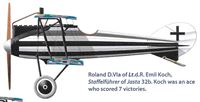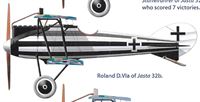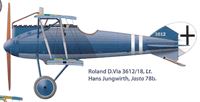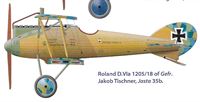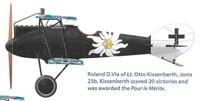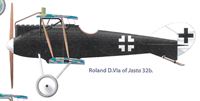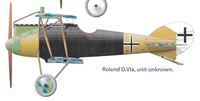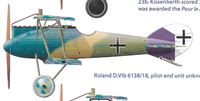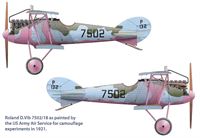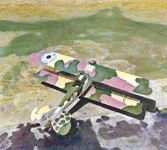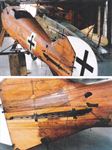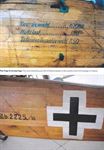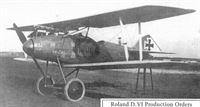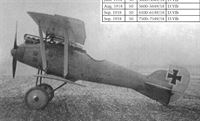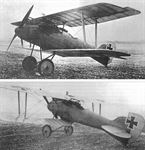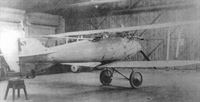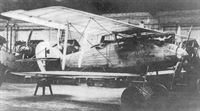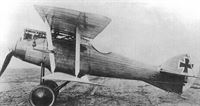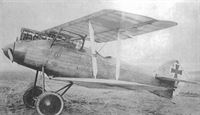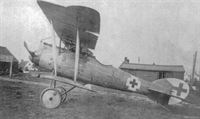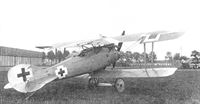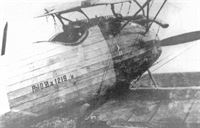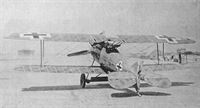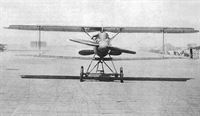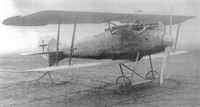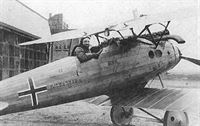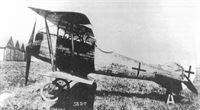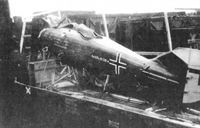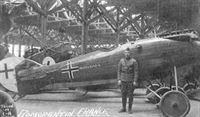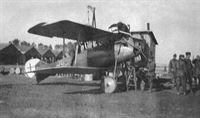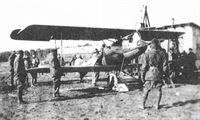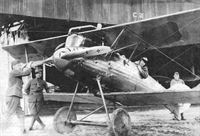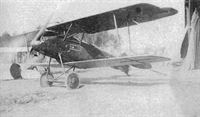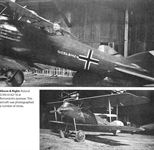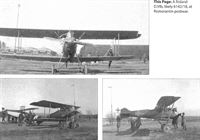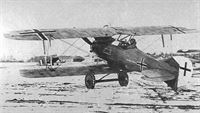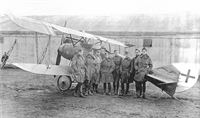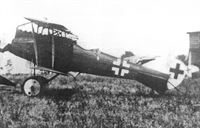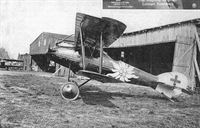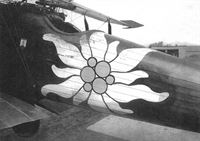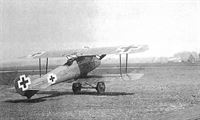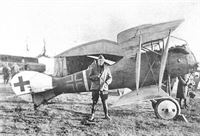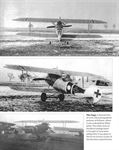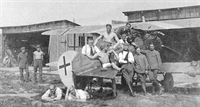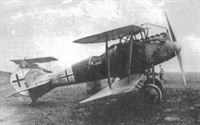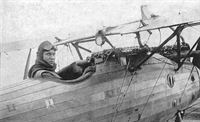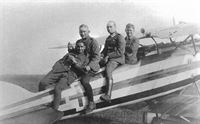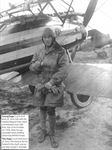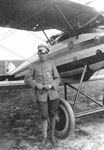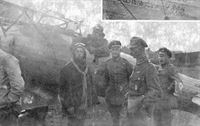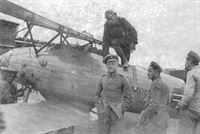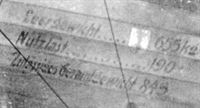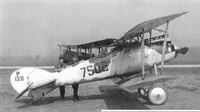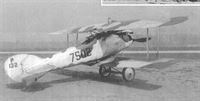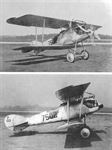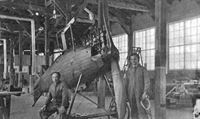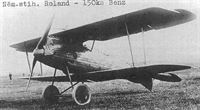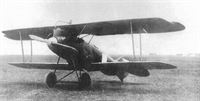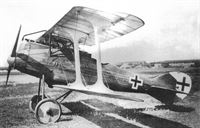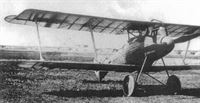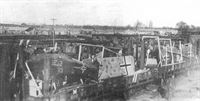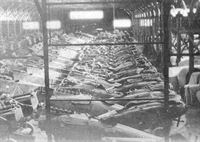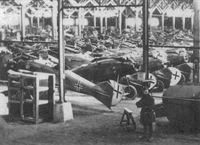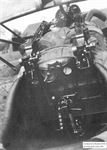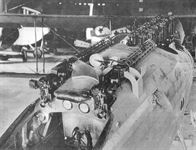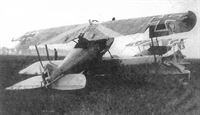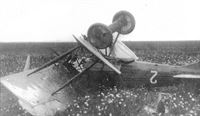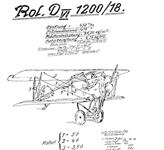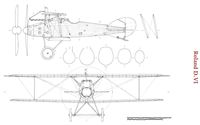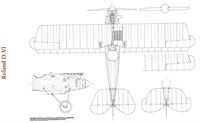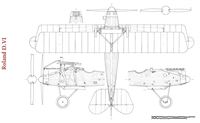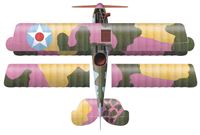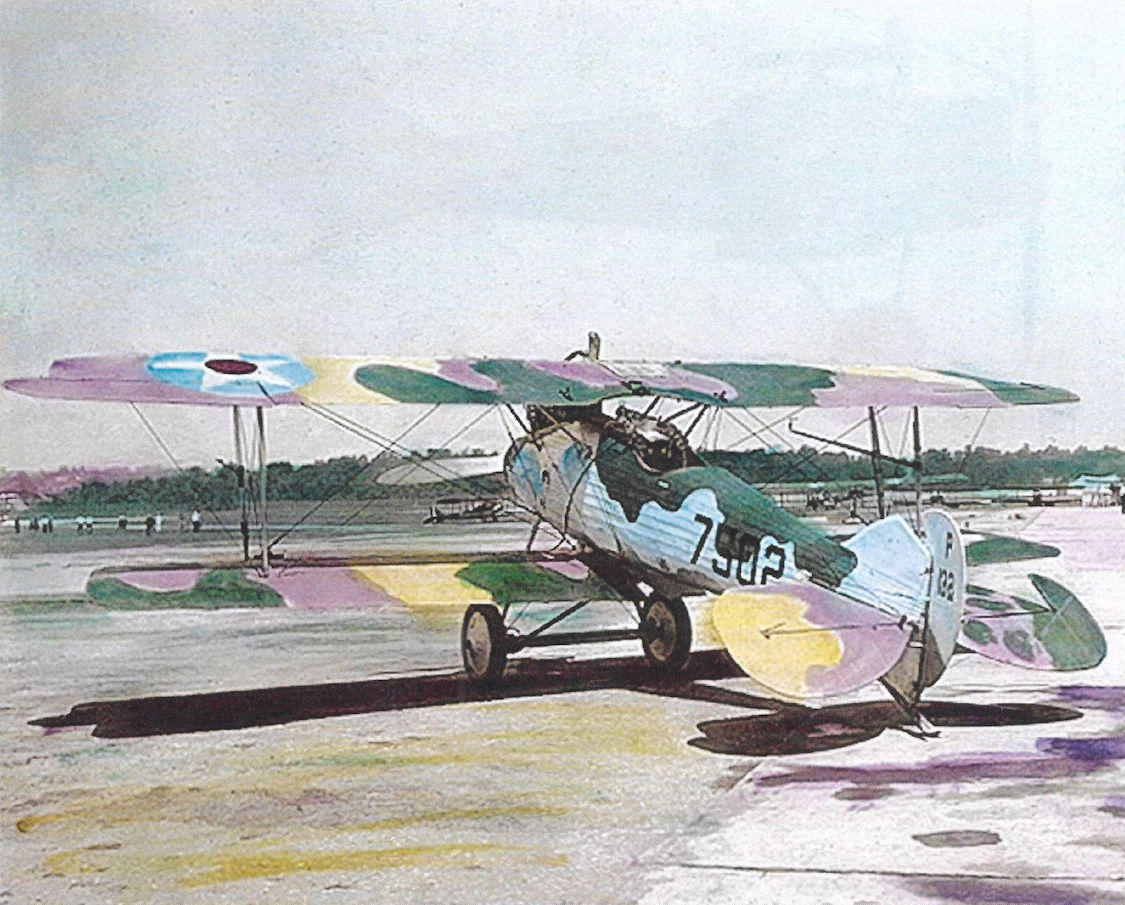
Описание
Страна: Германия
Год: 1918
Истребитель
Варианты
- LFG Roland - D.VI - 1918 - Германия
- LFG Roland - D.VII - 1918 - Германия
- LFG Roland - D.XIII/D.XV - 1918 - Германия
- В.Кондратьев Самолеты первой мировой войны
- O.Thetford, P.Gray German Aircraft of the First World War (Putnam)
- W.Green, G.Swanborough The Complete Book of Fighters
- J.Herris Roland Aircraft of WWI (A Centennial Perspective on Great War Airplanes 9)
- M.Dusing German Aviation Industry in WWI. Volume 1 (A Centennial Perspective on Great War Airplanes 84)
-
J.Herris - Development of German Warplanes in WWI /Centennial Perspective/ (1)
Roland D.VIa flown by Vzfw. Emil Schape in Jasta 33 in July 1918. The D.VIa had the 160 hp Mercedes D.III, while the similar D.VIb had the 185 hp Benz Bz.IIIa that gave it better performance. The D.VI used the Klinkerrumpf method of fuselage construction where the wood boards of the fuselage were overlapped like a boat hull. Many subsequent Roland designs also used this technology.
-
В.Кондратьев - Самолеты первой мировой войны
"Роланд" D.VIa, пилот Эмиль Шап, июль 1918г.
-
J.Herris - Roland Aircraft of WWI /Centennial Perspective/ (9)
Roland D.VIa of Lt.d.R. Emil Koch, Staffelfuhrer of Jasta 32b. Koch was an ace who scored 7 victories.
-
J.Herris - Roland Aircraft of WWI /Centennial Perspective/ (9)
Roland D.VIa of Jasta 32b.
-
J.Herris - Roland Aircraft of WWI /Centennial Perspective/ (9)
Roland D.VIa 3612/18, Lt. Hans Jungwirth, Jasta 78b.
-
J.Herris - Roland Aircraft of WWI /Centennial Perspective/ (9)
Roland D.VIa 1205/18 of Gefr. Jakob Tischner, Jasta 35b.
-
J.Herris - Roland Aircraft of WWI /Centennial Perspective/ (9)
Roland D.VIa of Lt. Otto Kissenberth, Jasta 23b. Kissenberth scored 20 victories and was awarded the Pour le Merite.
-
J.Herris - Roland Aircraft of WWI /Centennial Perspective/ (9)
Roland D.VIa of Jasta 32b.
-
J.Herris - Roland Aircraft of WWI /Centennial Perspective/ (9)
Roland D.VIa, unit unknown
-
J.Herris - Roland Aircraft of WWI /Centennial Perspective/ (9)
Roland D.VIb 6138/18, pilot and unit unknown
-
В.Кондратьев - Самолеты первой мировой войны
Роланд D.VIb, осень 1918г.
-
R.Bennett - Last Gathering of Eagles 1918-1920 /Aeronaut/
Roland D.VIb 7535/18, FA 406/Artillerie-Fliegerstaffel 127, Meseritz, 1919
-
J.Herris - Roland Aircraft of WWI /Centennial Perspective/ (9)
Roland D.VIb 7502/18 as painted by the US Army Air Service for camouflage experiments in 1921.
-
J.Herris - Roland Aircraft of WWI /Centennial Perspective/ (9)
The US Army Air Service used the Roland D.VIb as one of a number of aircraft in day camouflage experiments in 1921.
-
J.Herris - Roland Aircraft of WWI /Centennial Perspective/ (9)
The fuselage of Roland D.VIb 2225/18 in Poland
-
J.Herris - Roland Aircraft of WWI /Centennial Perspective/ (9)
The only remaining aircraft of Roland design in the world is this D.VI fuselage in Poland.
-
J.Herris - Roland Aircraft of WWI /Centennial Perspective/ (9)
The only remaining aircraft of Roland design in the world is this D.VI fuselage in Poland.
-
J.Herris - Aviatik Aircraft of WWI /Centennial Perspective/ (10)
The restored fuselage of Aviatik C.III 12250/17, one of the 200 ordered for training, in the museum in Poland. To its left is the fuselage of Roland D.VIb 2225/18.
Другие самолёты на фотографии: Aviatik C.III - Германия - 1916
-
J.Herris - Roland Aircraft of WWI /Centennial Perspective/ (9)
The Roland D.VI prototype was the 1,000th Roland-built aircraft. Powered by the proven 160 hp Mercedes D.III, it was the protoype for the D.VIa. Another D.VI powered by the 185 hp Benz Bz.IIIa was the prototype for the Roland D.VIb.
-
J.Herris - Roland Aircraft of WWI /Centennial Perspective/ (9)
Another view of the first Roland D.VI prototype; it was completed the morning of 27 Oct. 1917.
-
M.Dusing - German Aviation Industry in WWI. Volume 1 /Centennial Perspective/ (84)
This Rol D.VI was the 1000 LFG-aircraft.
-
J.Herris - Roland Aircraft of WWI /Centennial Perspective/ (9)
The second Roland D.VI prototype featured a redesigned fin and rudder in a search for improved handling and maneuverability.
-
J.Herris - Roland Aircraft of WWI /Centennial Perspective/ (9)
The second Roland D.VI prototype featured a redesigned fin and rudder with aerodynamic balance. The first three D.VI prototypes each had a different fin and rudder design in a search for better flying qualities.
-
J.Herris - Roland Aircraft of WWI /Centennial Perspective/ (9)
L.F.G. Roland D VIa (prototype)
-
J.Herris - Roland Aircraft of WWI /Centennial Perspective/ (9)
The second Roland D.VI prototype featured a redesigned fin and rudder; however, like the first prototype it was powered by a 160 hp Mercedes D.III engine.
-
J.Herris - Roland Aircraft of WWI /Centennial Perspective/ (9)
The third D.VI prototype flew at the First Fighter Competition. This prototype has an under-fuselage fin. Powered by the 185 hp Benz Bz.IIIa engine, it was the prototype of the Roland D.VIb. In addition to the different tail designs, the different D.VI prototypes tried both aerodynamically balanced and unbalanced ailerons and elevators, all in pursuit of the best maneuverability and handling qualities. All production D.VI aircraft settled on aerodynamically-balanced ailerons and rudders.The Mercedes-powered D.VIa and some early-production D.VIb fighters had unbalanced elevators, but aerodynamically-balanced elevators were standardized for the D.VIb.
-
J.Herris - Roland Aircraft of WWI /Centennial Perspective/ (9)
Roland D.VIa 1211/18 was the 12th aircraft in the first production batch. Despite being from the first 20 aircraft built, which are all thought to have the straight metal interplane struts, this aircraft now appears to have the all-wood interplane struts normally fitted to later-production aircraft.
-
J.Herris - Roland Aircraft of WWI /Centennial Perspective/ (9)
Roland D.VIa 1211/18 in service with Jasta 35b; the white chevron on the upper wing was part of the unit markings.
-
J.Herris - Roland Aircraft of WWI /Centennial Perspective/ (9)
Roland D.VIa 1219/18 was the 20th production aircraft and reportedly served with Jasta 30.
-
J.Herris - Roland Aircraft of WWI /Centennial Perspective/ (9)
Roland D.VIa 1223/18 served with Jasta 35b. Mostly in factory finish and markings, the chevron on top of the upper wing was part of the unit markings. Jasta 35b received its first five Roland D.VIa fighters from Armee-Flugpark 17 on May 7, 1918 and did not start receiving Fokker D.VII fighters until August 24, 1918. The Roland D.VIa was more maneuverable than the Albatros fighters the Jasta had used until then but otherwise offered little performance improvement. However, it was stronger than the Albatros and not subject to wing failure.
-
J.Herris - Roland Aircraft of WWI /Centennial Perspective/ (9)
Roland D.VIb 2216/18 undergoing evaluation at Adlershof in April-May 1918. This aircraft is from the second production batch, which was the first batch of D.VIb aircraft. According to official Idflieg drawings the D.VIb was supposed to receive an aerodynamically-balanced elevator, but this photo proves that was not fitted to all production D.VIb aircraft.
-
J.Herris - Roland Aircraft of WWI /Centennial Perspective/ (9)
This appears to be another photograph of Roland D.VIb 2216/18. The Roland D.VI had clean lines. The lower wing was attached to a pylon below the fuselage to provide sufficient wing gap to prevent airflow interference between the wings.
-
J.Herris - Roland Aircraft of WWI /Centennial Perspective/ (9)
Roland D.VIa 3612/18 was photographed at Koblenz postwar after it was delivered to the Americans. The aircraft was previously flown by Lt. Hans Jungwirth of Jasta 78b.
-
J.Herris - Roland Aircraft of WWI /Centennial Perspective/ (9)
Roland D.VIa 5012/18, an aircraft from the 4th production batch, was sent to Japan as war reparations and was photographed upon arrival.
-
J.Herris - Roland Aircraft of WWI /Centennial Perspective/ (9)
Roland D.VIa 5023/18, an aircraft from the 4th production batch, with Lottchen in the cockpit.
Wilhelm Eickhoff, test pilot at LFG in Hannover-Langenhagen, in a Roland D.VIa (5023/18), which was powered by a Mercedes D.III and Anker propeller. -
J.Herris - Roland Aircraft of WWI /Centennial Perspective/ (9)
Roland D.VIb 6117/18, with a painted nose and spinner, was an aircraft of the sixth production batch. Here it is in Allied hands after the Armistice.
-
J.Herris - Roland Aircraft of WWI /Centennial Perspective/ (9)
Roland D.VIb 6138/18 was an aircraft of the sixth production batch. Here it is stored by Americans after the Armistice. These late-production aircraft were finished like the Halberstadt CL.IV(Rol) in the NASM.
-
J.Herris - Roland Aircraft of WWI /Centennial Perspective/ (9)
Roland D.VIb 6142/18 disassembled and stored at Romorantin postwar.
-
J.Herris - Roland Aircraft of WWI /Centennial Perspective/ (9)
Roland D.VIb 6142/18 taxiing for takeoff at Romorantin postwar. This late-production aircraft was finished in the same colors that Roland used on their license-built Halberstadt CL.IV(Rol) aircraft.This is significant because one of these aircraft has been carefully restored and is now on display at the Udvar-Hazy facility of the National Air & Space Museum.
-
J.Herris - Roland Aircraft of WWI /Centennial Perspective/ (9)
Roland D.VIb, probably 6142/18, being readied for a test flight at Romorantin postwar.
-
J.Herris - Roland Aircraft of WWI /Centennial Perspective/ (9)
A Roland D.VIb, likely 6142/18, at Romorantin postwar.
-
J.Herris - Roland Aircraft of WWI /Centennial Perspective/ (9)
Americans starting Roland D.VIb 6142/18 at Romorantin postwar. The Roland D.VIa had the 170 hp Mercedes D IIIa; this engine was replaced by the 185 hp Benz Bz IIIa to create the Roland D.VIb. The Roland D.VIb was the only production aircraft to use the Benz Bz IIIa.
-
J.Herris - Roland Aircraft of WWI /Centennial Perspective/ (9)
Roland D.VIb 6142/18 ready for flight at Romorantin postwar.
-
J.Herris - Roland Aircraft of WWI /Centennial Perspective/ (9)
Roland D.VIb 6142/18 at Romorantin postwar. This aircraft was photographed a number of times.
-
J.Herris - Roland Aircraft of WWI /Centennial Perspective/ (9)
A Roland D.VIb, likely 6142/18, at Romorantin postwar.
-
J.Herris - Roland Aircraft of WWI /Centennial Perspective/ (9)
Roland D.VIb 7504/18, from the same production batch as its sister 7502/18, is shown postwar at Koblenz. As originally built by Roland it has the same factory finish as other late-production D.VIb aircraft shared with the Roland-built Halberstadt CL.IV(Rol) restored by NASM.
-
J.Herris - Roland Aircraft of WWI /Centennial Perspective/ (9)
An American pilot taxis a Roland D.VIb, perhaps 7504/18, for takeoff at Romorantin postwar.
-
J.Herris - Roland Aircraft of WWI /Centennial Perspective/ (9)
A group of Americans poses with late-production Roland D.VIb 7504/18 at Koblenz in 1919.
-
R.Bennett - Last Gathering of Eagles 1918-1920 /Aeronaut/
The Roland D.VIb was a rare bird among Freikorps aircraft. Like its FA 406 companion Halberstadt shown above, D.7535/18 has been stripped of its fuselage and tail crosses. (Author's collection)
-
В.Кондратьев - Самолеты первой мировой войны
Первые три "роланда" D.VIa на аэродроме в Иоханнештале.
-
J.Herris - Roland Aircraft of WWI /Centennial Perspective/ (9)
A dark-painted D.VIa of Jasta 32. The aircraft was painted at the unit.
-
J.Herris - Roland Aircraft of WWI /Centennial Perspective/ (9)
Although the Roland D.VI did not win the First Fighter Competition, it made a good enough showing that a small quantity of 50 was ordered for operational evaluation at the front. This spectacular example was flown by Pour le Merite ace Otto Kissenberth with Jasta 23b. A strong and maneuverable fighter, the Roland D.VI, like all other fighters, was overshadowed by the Fokker D.VII and production was limited.
-
J.Herris - Roland Aircraft of WWI /Centennial Perspective/ (9)
The spectacular Edelweiss marking on Pour le Merite ace Otto Kissenberth's Roland D.VIa of Jasta 23b
-
J.Herris - Roland Aircraft of WWI /Centennial Perspective/ (9)
Roland D.VI at Armee Flug Park 17.
-
J.Herris - Roland Aircraft of WWI /Centennial Perspective/ (9)
A Roland D.VI from Jasta 23b postwar with an American pilot in the foreground.
-
J.Herris - Roland Aircraft of WWI /Centennial Perspective/ (9)
"Роланд" D.VI захваченный американцами и увезенный после войны в США.
A Roland D.VIa of Jasta 23b photographed postwar at Koblenz, where it was evaluated by Allied pilots. The white circle on the black fuselage band is thought to have been added after it was given to the US Air Service as part of the Armistice requirements.
The Mercedes-engined D VIa (on photo) was, in other respects, similar to the Benz-engined D VIb. -
J.Herris - Roland Aircraft of WWI /Centennial Perspective/ (9)
Roland D.VI at the firing range at Adlershof testing its machine gun synchronization and aiming.
-
J.Herris - Roland Aircraft of WWI /Centennial Perspective/ (9)
Aircrew of Jasta 35b gather for an informal portrait with a Roland D.VI. Rudolf Stark, sitting on the tail in his swim trunks, was the Jastafuhrer. The chevron on the top wing was part of the unit markings.
-
J.Herris - Roland Aircraft of WWI /Centennial Perspective/ (9)
An unidentified D.VIa with a painted fuselage. A Fokker D.VII rests in the background.
Thanks to the relatively protracted development of the LFG Roland D VIb, only a small number of this 200hp Benz Bz IIIa powered single seater reached the Western Front prior to the Armistice. A handful also found their way to the Navy, where they were used to defend seaplane bases. Armed with twin 7.92mm Spandaus. the D VIb had a top level speed of 124mph at sea level, falling sharply to 113mph at 6,560 feet.Другие самолёты на фотографии: Fokker D.VII / V11 / V18 / V22 / V24 - Германия - 1917
-
O.Thetford, P.Gray - German Aircraft of the First World War /Putnam/
"Юбилейный" D.VI - двухтысячный аэроплан, построенный на фирме LFG.
L.F.G. Roland D Vlb. -
M.Dusing - German Aviation Industry in WWI. Volume 1 /Centennial Perspective/ (84)
The 2000th Roland aircraft was built in Charlottenburg: Roland D.VIb.
-
J.Herris - Roland Aircraft of WWI /Centennial Perspective/ (9)
A Roland D.VIa of Jasta 35b with an Albatros D.V or D.Va on the right.
Другие самолёты на фотографии: Albatros D.V/D.Va - Германия - 1917
-
J.Herris - Roland Aircraft of WWI /Centennial Perspective/ (9)
This Jasta 23b lineup is mostly Roland D.VIa fighters but includes at least two Pfalz D.IIIa fighters.
Другие самолёты на фотографии: Pfalz D.III/D.IIIa - Германия - 1917
-
J.Herris - Roland Aircraft of WWI /Centennial Perspective/ (9)
Roland D.VIa with its pilot in the cockpit ready for a mission. The four vents on the starboard nose were an indication of the Mercedes engine being used.
-
J.Herris - Roland Aircraft of WWI /Centennial Perspective/ (9)
A spectacularly-painted Roland D.VIa of Jasta 32b; Uffz. Krautheim at left with Uffz. Marchner next; the other men are unknown.
-
J.Herris - Roland Aircraft of WWI /Centennial Perspective/ (9)
Lt.d.R. Emil Koch of Jasta 32b ready to fly his Roland D.VIa. Koch was an ace who scored 7 victories.
-
J.Herris - Roland Aircraft of WWI /Centennial Perspective/ (9)
Lt.d.R. Emil Koch of Jasta 32b with his colorful Roland D.VIa. Koch commanded Jasta 32b from July 23 to October 24,1918, when he was wounded while strafing advancing British troops.
-
J.Herris - Roland Aircraft of WWI /Centennial Perspective/ (9)
Roland D.VIa 12xx/18. The fuselage insignia has been overpainted. The men and unit are unidentified.
-
J.Herris - Roland Aircraft of WWI /Centennial Perspective/ (9)
Roland D.VIa 12xx/18. The fuselage insignia has been overpainted. The men and unit are unidentified.
-
J.Herris - Roland Aircraft of WWI /Centennial Perspective/ (9)
Closeup of the data painted on the fuselage of Roland D.VIa 12xx/18.
-
J.Herris - Roland Aircraft of WWI /Centennial Perspective/ (9)
Roland D.VIb 7502/18 from the final Roland D.VI production batch was brought to America after the war. Later it was used for a series of camouflage experiments by the U.S. Army as shown here.
-
J.Herris - Roland Aircraft of WWI /Centennial Perspective/ (9)
Roland D.VIb with Benz Bz IIIa after the end of the war for research purposes on American McCook test field of the US Army.
-
J.Herris - Roland Aircraft of WWI /Centennial Perspective/ (9)
A Roland D.VI in Ottawa; America was not the only recipient of war-booty Rolands postwar, nor the only country to fail to preserve one for future generations.
-
J.Herris - Roland Aircraft of WWI /Centennial Perspective/ (9)
Roland D.VI in Czechoslovakian service postwar. Czechoslovakia was apparently the only other country other than the USA to use the Roland D.VI postwar. A small but unknown number were used.
Roland D.VIb 2253/18 was flown in 1919-1920 by Czechoslovakia. -
J.Herris - Roland Aircraft of WWI /Centennial Perspective/ (9)
Roland D.VI in Czechoslovakian service postwar. Roland D.VI with smooth, apparently monocoque fuselage; no details of this interesting modification are available.
-
J.Herris - Roland Aircraft of WWI /Centennial Perspective/ (9)
The LFG Roland D VIb was one of the designs for the 1918 fighter competition. The Germans had realized that numerical superiority rested with the Allies and so instead concentrated on trying to achieve technical superiority. Only limited numbers of the Roland VIb were built and they were mainly used by the Navy for seaplane defence duties. The Roland D VIb fighter began to reach combat units at the Front in mid-1918.
-
J.Herris - Roland Aircraft of WWI /Centennial Perspective/ (9)
D.VIb 2217/18 photographed on June 10,1918, was used for a series of tests to investigate an extremely flat wing profile. Interestingly, the new wings were supported by four I-struts.
-
J.Herris - Roland Aircraft of WWI /Centennial Perspective/ (9)
Another photograph of D.VIb 2217/18 taken on June 10, 1918, during its use for a series of airfoil tests. (190 h.p. Benz engine.)
-
J.Herris - Roland Aircraft of WWI /Centennial Perspective/ (9)
Disassembled and packed Roland D.VI fighters on the train on their way to the front.
-
J.Herris - Roland Aircraft of WWI /Centennial Perspective/ (9)
Late-production Roland D.VI aircraft stored at Romorantin postwar. These aircraft were to be shipped to America, and some were. With all these pristine aircraft available, how is it that none were preserved in a museum?
-
J.Herris - Roland Aircraft of WWI /Centennial Perspective/ (9)
Late-production Roland D.VI fighters in storage at Romorantin postwar.
-
J.Herris, J.Leckscheid - Fokker Aircraft of WWI. Vol.5: 1918 Designs Part 1: Prototypes & D.VI /Centennial Perspective/ (55)
A trio of D.VIs, at least one of them from Jasta 80b, seen amongst Fokker D.VIIs and Roland D.VIs after being turned over to the French after the armistice. The photo was probably taken at Neunkirchen or Saargemund. Many surrendered German fighters were gathered here. (Peter M. Grosz Collection/STDB)
Другие самолёты на фотографии: Fokker D.VI / V9 / V12 / V13 / V33 - Германия - 1917Fokker D.VII / V11 / V18 / V22 / V24 - Германия - 1917
-
J.Herris - Roland Aircraft of WWI /Centennial Perspective/ (9)
Cockpit of a Roland D.VIa serving with Jasta 35b.
-
J.Herris - Roland Aircraft of WWI /Centennial Perspective/ (9)
This closeup of a disassembled Roland D.VIb shows details of the cockpit, guns, and engine.
-
J.Herris - Roland Aircraft of WWI /Centennial Perspective/ (9)
The first Roland D.VIa fighters arrived at Jasta 35b on May 14, 1918. This early-production D.VIa (identified by its straight metal interplane struts faired with wood) was damaged by Albatros D.Va 7186/17 (in the background) while being flown by Lt. Borner on June 1, 1918. The chevron on the top of the upper wing was a unit marking.
Другие самолёты на фотографии: Albatros D.V/D.Va - Германия - 1917
-
J.Herris - Roland Aircraft of WWI /Centennial Perspective/ (9)
Roland D.VIb 6141/18 crashed by German pilot Lt. Hans Christian Donhauser of Jasta 17 on January 1, 1919 at Coblenz. He walked away, but was later killed in a crash during a test flight. Such accidents were regarded as normal at the time.
-
J.Herris - Roland Aircraft of WWI /Centennial Perspective/ (9)
Crash of Czechoslovakian Roland D.VI number "2".
-
J.Herris - Roland Aircraft of WWI /Centennial Perspective/ (9)
Roland D.VI rigging diagram.
-
W.Green, G.Swanborough - The Complete Book of Fighters
The Mercedes-engined D VIa was, in other respects, similar to the Benz-engined D VIb (on scheme) .
-
В.Кондратьев - Самолеты первой мировой войны
Roland D.VI
В.Кондратьев Самолеты первой мировой войны
Метод изготовления фюзеляжей, применявшийся на ранних "роландах", обеспечивал хорошие результаты в области аэродинамики и весовых характеристик, однако он отличался высокой трудоемкостью и длительностью производственного процесса. Для ускорения и удешевления производства инженер Танцен летом 1917 года разработал новый способ сборки фюзеляжей по так называемому "корабельному" принципу. Он заключался в том, что ажурный деревянный каркас из овальных шпангоутов и стрингеров обшивался длинными и узкими продольными полосками шпона, соединенными внахлест. В результате получилась очень легкая и технологичная конструкция, не уступавшая по прочности "скорлупе" выклеенной на болванке.
Истребитель с новым фюзеляжем получил индекс D.VI. Он впервые поднялся в воздух 13 октября 1917 года, а в январе 1918-го принял участие в конкурсе перспективных моделей истребителей в Адлерсхофе. И хотя победителем на этом конкурсе был объявлен "Фоккер" D.VII, испытатели отметили высокую скорость, хорошую маневренность и выдающиеся взлетно-посадочные характеристики нового "Роланда".
Помимо "корабельной" обшивки, отличительным признаком этой машины стало применение двигателя "Бенц" Bz.III с повышенной степенью сжатия, обладавшего мощностью 185 л.с, который обеспечил самолету отличные летные данные. "Роланд" D.VI - единственный серийный истребитель, оснащавшийся этим мотором. Но выпуск "бенцев" был весьма ограничен, поэтому на значительную часть "роландов" ставили менее мощные "мерседесы" D.IIIa в 175 л.с. Модификация с "Мерседесом" обозначалась D.VIa, а с "Венцем" - D.VIb. Вооружение обеих модификаций - два синхронных пулемета LMG08/15.
Первый заказ на 50 D.VIa поступил в феврале 1918-го, а на D.VIb - в апреле того же года. Всего до конца войны заказано 150 D.VIa и 200 D.VIb (последних успели построить около 180).
Первые "шестерки" поступили на западный фронт в мае 1918-го. В июне их насчитывалось 55 штук, в августе это число увеличилось до 70. Несколько десятков машин провоевали до окончания боевых действий.
МОДИФИКАЦИИ
D.VI; двигатель "Мерседес", 160 л.с.
D.VIa; двигатель "Мерседес", 180 л.с. Элероны с роговой компенсацией.
D.VIb; двигатель "Бенц", 200 л.с. Измененная форма вертикального оперения.
ВООРУЖЕНИЕ: 2 синхр. LMG 08/15 "Шпандау".
ЛЕТНО-ТЕХНИЧЕСКИЕ ХАРАКТЕРИСТИКИ
D.VIa D.VIb
Размах, м 9,39 9.39
Длина, м 6,40 6,40
Площадь крыла, кв.м 21,7 21,7
Сухой вес, кг 655 670
Взлетный вес, кг 845 850
Скорость максимальная, км/ч 190 200
Время подъема на высоту
2000 м, мин 6,0 4,9
Потолок, м 5800 5800
Описание:



